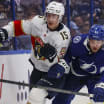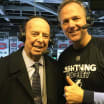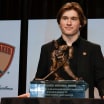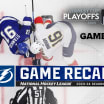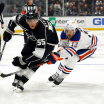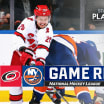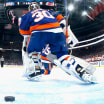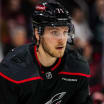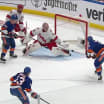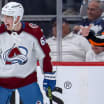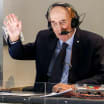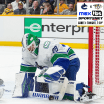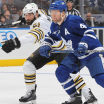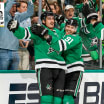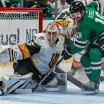NHL Commissioner Gary Bettman entered the bubble in Edmonton on Sept. 10 and went into quarantine. Like anyone else from the outside, he had to spend four days in his hotel room. The next three days, he could leave his room only for essential work.
NHL postseason bubbles successful because 'everybody bought into this'
League staff, teams made safety priority, adhered to protocols in Edmonton, Toronto
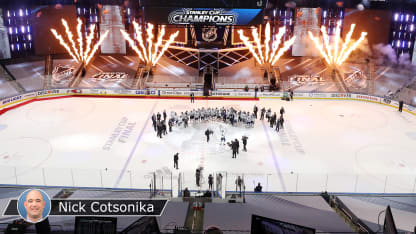
His first morning of relative freedom, he met NHL chief content officer Steve Mayer in the lobby.
"He said, 'I want to give you a tour of the bubble,'" Commissioner Bettman said. "I said, 'Great. I want to go outside first. I want to breathe some fresh air.'"
On the tour, Commissioner Bettman was amazed. Even though he had been deeply involved, speaking to Mayer three or four times a day, taking his call no matter what he was doing, it was one thing to see it from afar. It was another to see it in person.
After pausing the season March 12 due to concerns surrounding the coronavirus, the NHL returned with an unprecedented 24-team tournament. Twelve Eastern Conference teams entered the bubble in Toronto on July 26, confined mainly to two hotels and Scotiabank Arena. Twelve Western Conference teams entered in Edmonton the same day, confined mainly to two hotels and Rogers Place. The postseason began Aug. 1.
Now the League had reached the conference finals. Four teams shared one hotel in Edmonton while playing at Rogers Place.
"He turned to me and he said, 'How in the world did you do this with 12 teams?'" Mayer said. "And I took that as a very strong compliment. And I actually sometimes wonder how we did it. We sort of made this up as we went along. We didn't have the experience of doing a bubble."
Mayer laughed.
"No one did," he continued. "And you make decisions based on what you think are the logical choices, but you don't know if they're going to be good decisions. … I do believe there were low expectations, and I think we exceeded them."
RELATED: ['Inside the Bubble' video | Bettman proud of NHL's accomplishments with Stanley Cup, hub cities]
The NHL had two main goals: Keep everyone safe and award the Stanley Cup with integrity.
The League said Monday that out of 33,174 tests administered to team personnel since the teams entered the bubbles July 26, zero were positive for COVID-19.
That night, the Tampa Bay Lightning raised the Stanley Cup after defeating the Dallas Stars 2-0 in Game 6 of the Stanley Cup Final.
Considering they had spent 65 days in the bubble, isolated from family and friends and the outside world, playing without fans in the stands, Commissioner Bettman said during the Cup presentation on the ice, "This Stanley Cup run will go down in the record books as perhaps the hardest run of all times."
The NHL staged 130 games in 59 days, transforming empty arenas with seat covers, video screens and concert lights to put on a made-for-TV show for fans at home.
"I usually don't have very many emotions after we pull an event off, because I know we're on to the next one," said Mayer, who oversaw everything. "I've always been one to never rest on what we just did and just look forward to how do we make something bigger and better. But on this one, I mean, it's just been so different and so unique and like nothing that any of us have ever done before. Yeah, I mean, this is quite emotional.
"Our entire staff, we've made unbelievable sacrifices, but for a common cause that we all realize was well worth those sacrifices. To have accomplished what we've accomplished, we're very proud of it. We were just doing our job, but I really do believe that each and every one of us went above and beyond to get this done, and it's one that will go down as one of the greatest career moments for all of us."
* * * * *
Safety was most important.
"We said a long time ago that we wouldn't breathe a sigh of relief until the Cup was raised, and so having gotten to that point without any positive tests amongst the teams is a huge sigh of relief," NHL chief medical officer Willem Meeuwisse said. "There were so many unknowns when we embarked on this journey. There was so little science. No one had done this before. We had a lot of things that took some educated guesswork. And it's really rewarding to see it come to fruition."
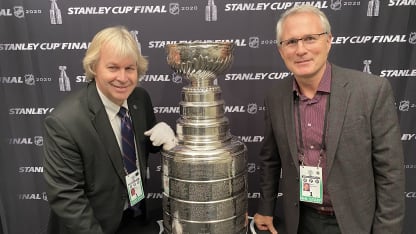
Medical experts and government officials devised detailed, strict safety protocols. Yes, everyone had to undergo daily COVID-19 testing with nasal swabs. But all those tests wouldn't have come back negative without prevention and buy-in from everyone. No exceptions.
People couldn't come and go. The few who did leave and return, or enter from the outside, had to isolate themselves and pass three COVID-19 tests 48 hours apart within seven days before arrival. Then they had to quarantine in their hotel rooms for four days and pass four more tests. Then they could leave their rooms only for essential work for three days afterward.
That included Commissioner Bettman and Deputy Commissioner Bill Daly. That included Meeuwisse, who oversaw the protocols in Toronto and Edmonton, had to travel between cities, and had to go through the quarantine three times himself.
"I had to take my own medicine," Meeuwisse said.
To move in the bubble, everyone had to get a health pass every 12 hours by answering a questionnaire on a smartphone app and having their temperature taken at a touch-free, automated kiosk. Everyone had to wear a mask. Everyone had to socially distance. Everyone had to wash or sanitize their hands.
Meanwhile, cleaning crews sterilized everything, from the locker rooms between games and practices, to the benches and penalty boxes between periods.
"The prevention piece is the keystone in all of this, because if you're just chasing your tail trying to correct things after the fact, you're doing contact tracing and trying to limit the damage," Meeuwisse said. "For sure the best approach is to prevent any transmission or outbreak in the first place.
"I think the key ingredient of success is really the way everybody bought into this, from the players to the coaches and support staff, even the hotel workers and all of the other people that were involved in the bubble. [Everyone] took it seriously. When doing things like wearing a mask and washing your hands and social distancing become tedious and boring, they stuck with it, and I think because of that, that's probably the biggest reason why this worked."
The NHL wouldn't have done this if it wasn't confident it could do so safely. But zero positive tests?
"I think sometimes you go, 'How the hell did we just do this?'" Mayer said. "Did I come here thinking we would be COVID free? No way. And I'll be very honest with you. I felt like we had a plan in place if indeed someone came down with COVID, and we would have executed it had it ever happened, and you know, we just didn't have to do it.
"I truly believe this is a model for society to come back online. I know we had daily testing, and that's unique to what we set up. But we also had protocols in place that were super smart and then executed by everybody in this bubble. Everybody wore their mask. Everybody social distanced. Everybody cared about the person they were next to."
Mayer stood in an outdoor plaza area as he spoke. He described two players sitting at a table, each wearing a mask. He described people eating while socially distanced. And this was after more than two months.
"It's like, all the way until the end, people have complied with the rules, and they've been OK with it, and those are the people that made this a success," Mayer said. "We did what we had to do as an events staff, but we would have never succeeded if people didn't buy in. Never."
* * * * *
Safety meant sacrifice.
There was no escaping what the protocols required. Few family members entered the bubble and only toward the end. But the NHL tried to make everyone as comfortable as possible, from pop-up restaurants to ordering pingpong tables to organizing excursions outside the bubble.
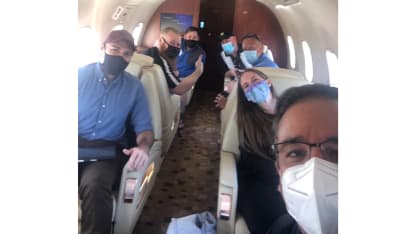
Many NHL staff members were in the bubble longer than the Lightning or Stars. Mayer and a few others arrived July 14 and stayed 78 days.
"You try your best, but you just …" Mayer said, his voice trailing off for a moment. "You just hope that you're OK, and you hope that you're going to keep people happy through the amount of time that they're there. And listen, it's not all perfect, and I've never said, 'This is incredible. This is amazing.' But you know, we are proud that everybody's going to leave here having spent a significant amount of days, and they're OK with it."
In the end, all the sacrifices were for the game.
Perhaps the most normal thing was the actual product on the ice and on television. The players competed for the Cup hard, as always. The NHL didn't just try to make the best of a bad situation; it tried to turn a bad situation into something spectacular for the TV audience.
"I really do think that we came up with a clean look that worked," Mayer said. "The best compliment is, people have said is, 'Hey, I'm watching these games and I forgot the fact there are no fans. They're super entertaining.'
"We tried to highlight our star players. Guy makes a big play, put him in the big screens. Let's get people to know not only who Brayden Point is, but every player on Tampa. Let's highlight just some of the great highlights and looks and add music. Let's make it a little bit of a show.
"That's what I love to do, and that's what I think we were able to accomplish, yes. Total team effort."
The Lightning weren't the only team of champions. Commissioner Bettman said Mayer and his team were "unbelievable." Credit goes to Mayer and executive vice president Dean Matsuzaki; to vice presidents Bill Miller, Joe Fitzgerald and Dan O'Neill, to … The only problem is that the list is too long.
"I kept on getting asked, 'What's the attitude? Do people want to get out? Are people sick of being in the bubble?'" Mayer said. "And the answer was always no. I felt like we wanted to finish what we started, and all of us just wanted to get there, didn't want COVID to creep up or something else to happen that would throw us off. We just all wanted to get that final moment to happen, and once it did …
"We got here. We did it. We'll always remember this forever, and you'll always remember the people you did it with, that came along for the ride, because this is the greatest ride we've ever been on."
